Griffith University: Project 1 Safety Risk Assessment Report
VerifiedAdded on 2023/01/18
|11
|3449
|92
Report
AI Summary
This report presents a safety risk assessment based on a provided dataset of safety reports. The assessment involves skimming reports, identifying common safety events and stakeholders, and organizing data. It defines variables for hazard and consequence analysis, codes narratives, and creates pivot tables and charts to generate insights. The report uses a modified bow-tie framework to analyze contributing factors, hazards, safety events, and consequences. It describes the safety event and stakeholder perspectives, lists safety reports, and justifies hazards and contributing factors with charts. The risk is assessed using an ICAO risk matrix, and recommendations are provided to reduce the probability and severity of identified hazards. The report also provides a table of 20 safety reports with ACN numbers and synopses. The report aims to analyze and mitigate risks in the context of safety management.
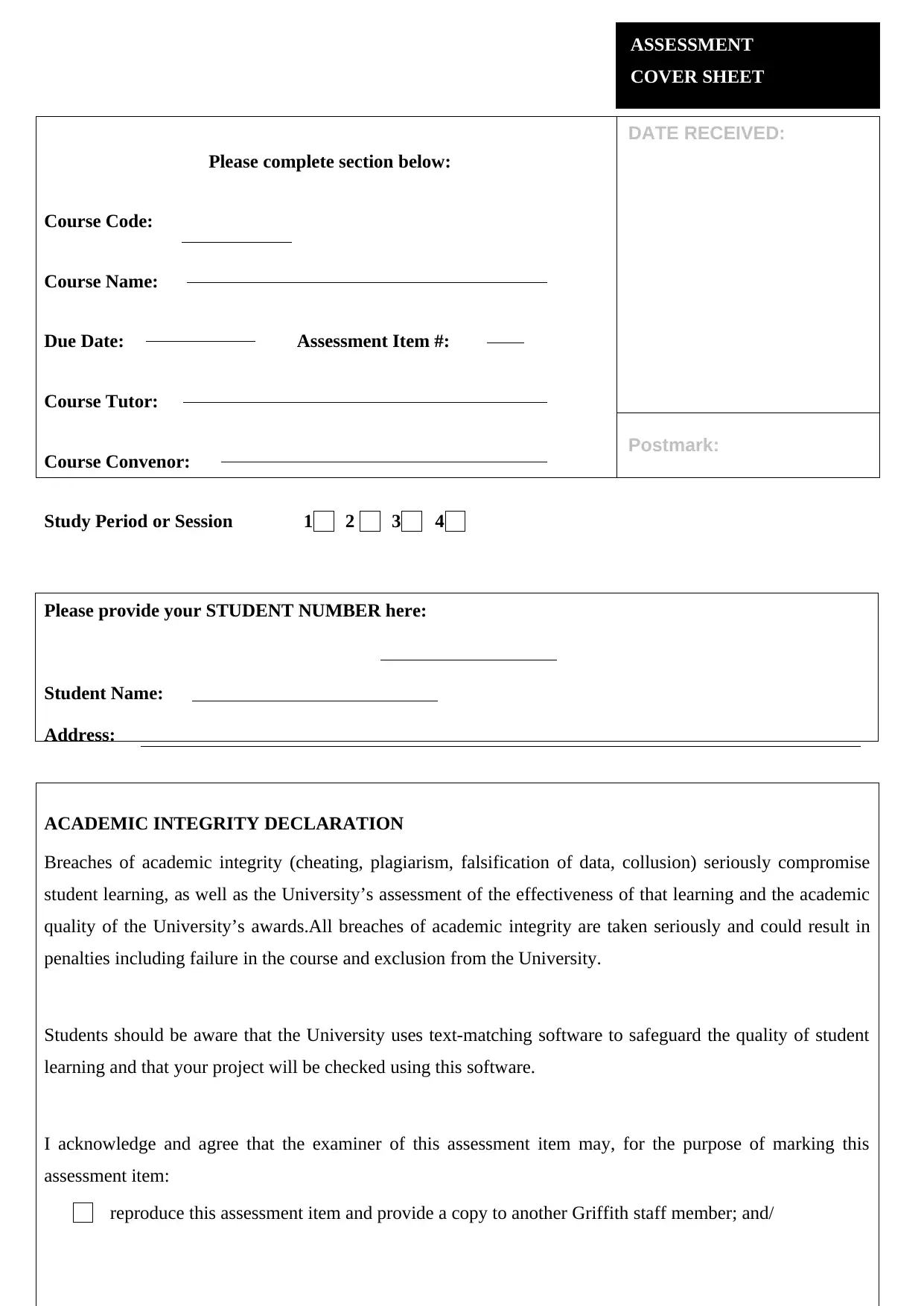
DATE RECEIVED:
Postmark:
ASSESSMENT
COVER SHEET
Please complete section below:
Course Code:
Course Name:
Due Date: Assessment Item #:
Course Tutor:
Course Convenor:
Study Period or Session 1 2 3 4
Please provide your STUDENT NUMBER here:
Student Name:
Address:
ACADEMIC INTEGRITY DECLARATION
Breaches of academic integrity (cheating, plagiarism, falsification of data, collusion) seriously compromise
student learning, as well as the University’s assessment of the effectiveness of that learning and the academic
quality of the University’s awards.All breaches of academic integrity are taken seriously and could result in
penalties including failure in the course and exclusion from the University.
Students should be aware that the University uses text-matching software to safeguard the quality of student
learning and that your project will be checked using this software.
I acknowledge and agree that the examiner of this assessment item may, for the purpose of marking this
assessment item:
reproduce this assessment item and provide a copy to another Griffith staff member; and/
Postmark:
ASSESSMENT
COVER SHEET
Please complete section below:
Course Code:
Course Name:
Due Date: Assessment Item #:
Course Tutor:
Course Convenor:
Study Period or Session 1 2 3 4
Please provide your STUDENT NUMBER here:
Student Name:
Address:
ACADEMIC INTEGRITY DECLARATION
Breaches of academic integrity (cheating, plagiarism, falsification of data, collusion) seriously compromise
student learning, as well as the University’s assessment of the effectiveness of that learning and the academic
quality of the University’s awards.All breaches of academic integrity are taken seriously and could result in
penalties including failure in the course and exclusion from the University.
Students should be aware that the University uses text-matching software to safeguard the quality of student
learning and that your project will be checked using this software.
I acknowledge and agree that the examiner of this assessment item may, for the purpose of marking this
assessment item:
reproduce this assessment item and provide a copy to another Griffith staff member; and/
Paraphrase This Document
Need a fresh take? Get an instant paraphrase of this document with our AI Paraphraser
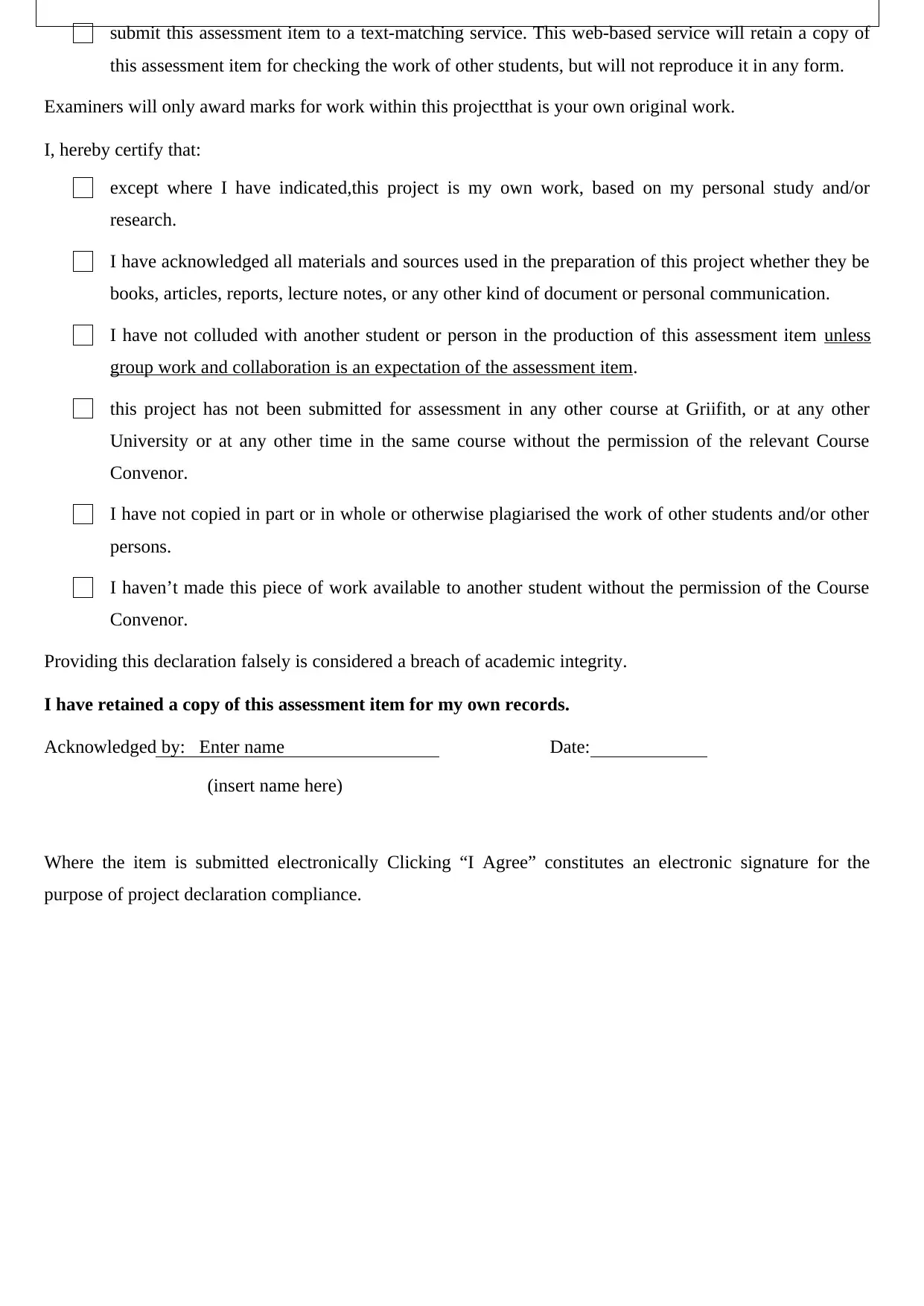
submit this assessment item to a text-matching service. This web-based service will retain a copy of
this assessment item for checking the work of other students, but will not reproduce it in any form.
Examiners will only award marks for work within this projectthat is your own original work.
I, hereby certify that:
except where I have indicated,this project is my own work, based on my personal study and/or
research.
I have acknowledged all materials and sources used in the preparation of this project whether they be
books, articles, reports, lecture notes, or any other kind of document or personal communication.
I have not colluded with another student or person in the production of this assessment item unless
group work and collaboration is an expectation of the assessment item.
this project has not been submitted for assessment in any other course at Griifith, or at any other
University or at any other time in the same course without the permission of the relevant Course
Convenor.
I have not copied in part or in whole or otherwise plagiarised the work of other students and/or other
persons.
I haven’t made this piece of work available to another student without the permission of the Course
Convenor.
Providing this declaration falsely is considered a breach of academic integrity.
I have retained a copy of this assessment item for my own records.
Acknowledged by: Enter name Date:
(insert name here)
Where the item is submitted electronically Clicking “I Agree” constitutes an electronic signature for the
purpose of project declaration compliance.
this assessment item for checking the work of other students, but will not reproduce it in any form.
Examiners will only award marks for work within this projectthat is your own original work.
I, hereby certify that:
except where I have indicated,this project is my own work, based on my personal study and/or
research.
I have acknowledged all materials and sources used in the preparation of this project whether they be
books, articles, reports, lecture notes, or any other kind of document or personal communication.
I have not colluded with another student or person in the production of this assessment item unless
group work and collaboration is an expectation of the assessment item.
this project has not been submitted for assessment in any other course at Griifith, or at any other
University or at any other time in the same course without the permission of the relevant Course
Convenor.
I have not copied in part or in whole or otherwise plagiarised the work of other students and/or other
persons.
I haven’t made this piece of work available to another student without the permission of the Course
Convenor.
Providing this declaration falsely is considered a breach of academic integrity.
I have retained a copy of this assessment item for my own records.
Acknowledged by: Enter name Date:
(insert name here)
Where the item is submitted electronically Clicking “I Agree” constitutes an electronic signature for the
purpose of project declaration compliance.
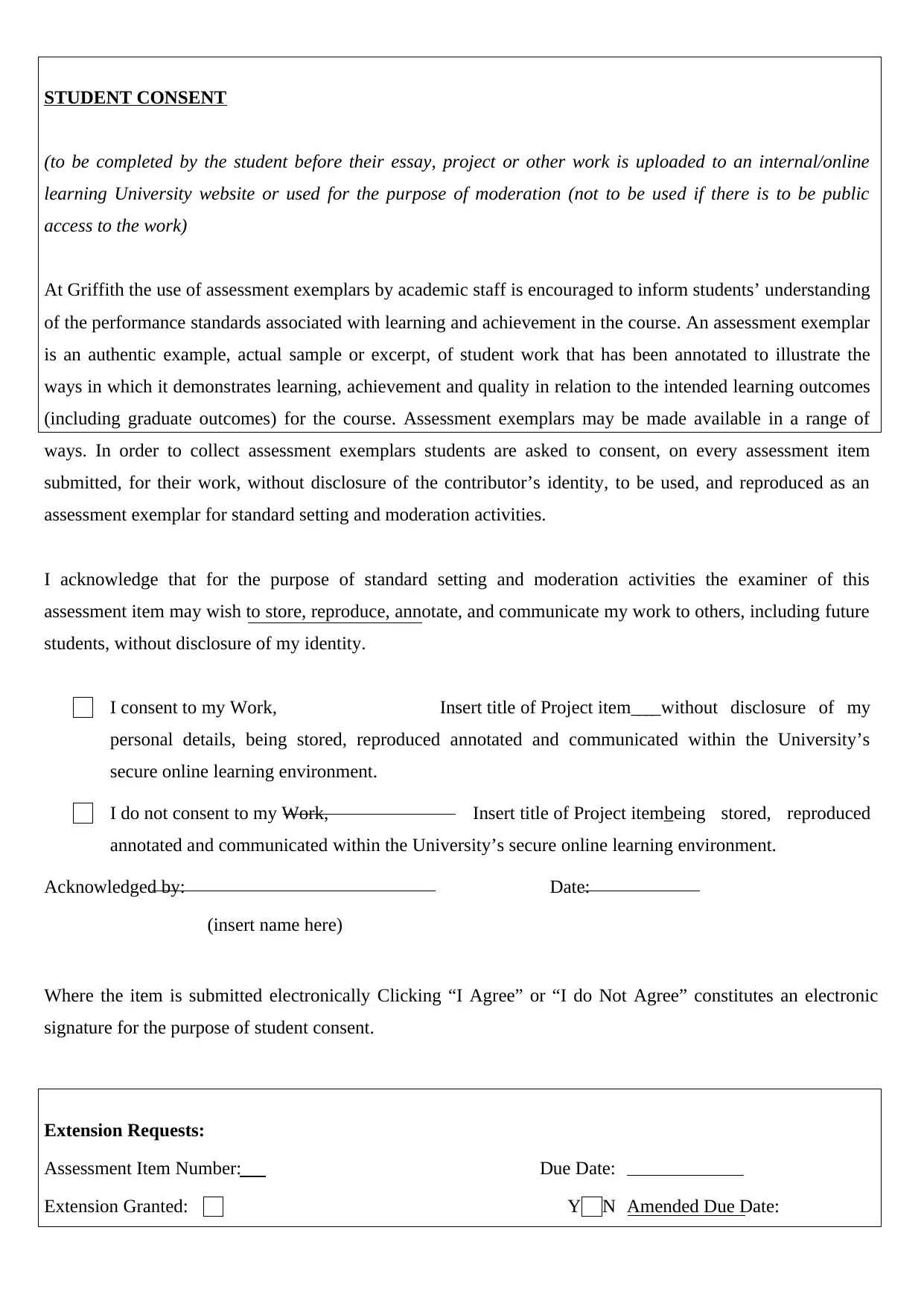
STUDENT CONSENT
(to be completed by the student before their essay, project or other work is uploaded to an internal/online
learning University website or used for the purpose of moderation (not to be used if there is to be public
access to the work)
At Griffith the use of assessment exemplars by academic staff is encouraged to inform students’ understanding
of the performance standards associated with learning and achievement in the course. An assessment exemplar
is an authentic example, actual sample or excerpt, of student work that has been annotated to illustrate the
ways in which it demonstrates learning, achievement and quality in relation to the intended learning outcomes
(including graduate outcomes) for the course. Assessment exemplars may be made available in a range of
ways. In order to collect assessment exemplars students are asked to consent, on every assessment item
submitted, for their work, without disclosure of the contributor’s identity, to be used, and reproduced as an
assessment exemplar for standard setting and moderation activities.
I acknowledge that for the purpose of standard setting and moderation activities the examiner of this
assessment item may wish to store, reproduce, annotate, and communicate my work to others, including future
students, without disclosure of my identity.
I consent to my Work, Insert title of Project item____without disclosure of my
personal details, being stored, reproduced annotated and communicated within the University’s
secure online learning environment.
I do not consent to my Work, Insert title of Project item_being stored, reproduced
annotated and communicated within the University’s secure online learning environment.
Acknowledged by: Date:
(insert name here)
Where the item is submitted electronically Clicking “I Agree” or “I do Not Agree” constitutes an electronic
signature for the purpose of student consent.
Extension Requests:
Assessment Item Number: Due Date:
Extension Granted: Y N Amended Due Date:
(to be completed by the student before their essay, project or other work is uploaded to an internal/online
learning University website or used for the purpose of moderation (not to be used if there is to be public
access to the work)
At Griffith the use of assessment exemplars by academic staff is encouraged to inform students’ understanding
of the performance standards associated with learning and achievement in the course. An assessment exemplar
is an authentic example, actual sample or excerpt, of student work that has been annotated to illustrate the
ways in which it demonstrates learning, achievement and quality in relation to the intended learning outcomes
(including graduate outcomes) for the course. Assessment exemplars may be made available in a range of
ways. In order to collect assessment exemplars students are asked to consent, on every assessment item
submitted, for their work, without disclosure of the contributor’s identity, to be used, and reproduced as an
assessment exemplar for standard setting and moderation activities.
I acknowledge that for the purpose of standard setting and moderation activities the examiner of this
assessment item may wish to store, reproduce, annotate, and communicate my work to others, including future
students, without disclosure of my identity.
I consent to my Work, Insert title of Project item____without disclosure of my
personal details, being stored, reproduced annotated and communicated within the University’s
secure online learning environment.
I do not consent to my Work, Insert title of Project item_being stored, reproduced
annotated and communicated within the University’s secure online learning environment.
Acknowledged by: Date:
(insert name here)
Where the item is submitted electronically Clicking “I Agree” or “I do Not Agree” constitutes an electronic
signature for the purpose of student consent.
Extension Requests:
Assessment Item Number: Due Date:
Extension Granted: Y N Amended Due Date:
⊘ This is a preview!⊘
Do you want full access?
Subscribe today to unlock all pages.

Trusted by 1+ million students worldwide
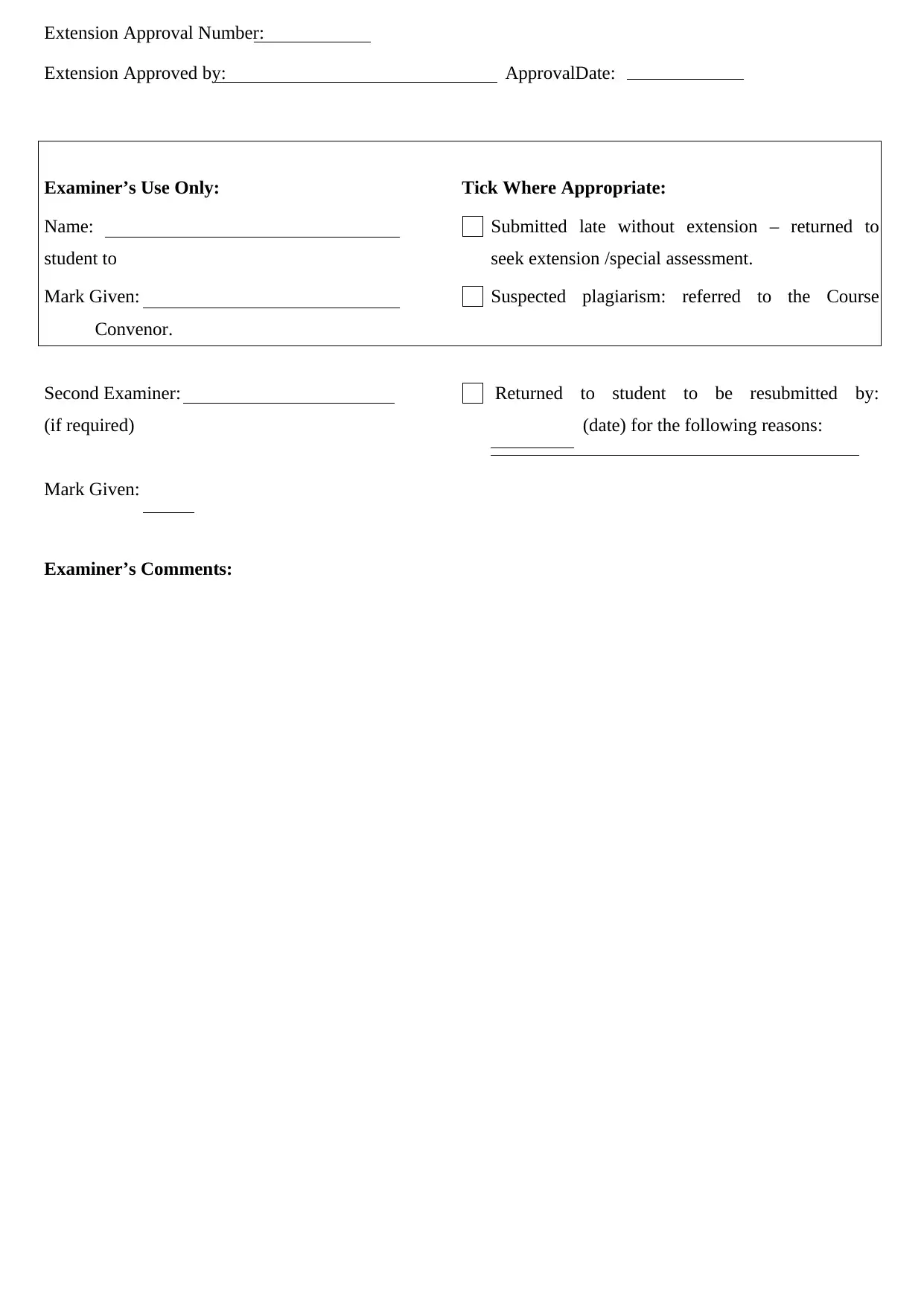
Extension Approval Number:
Extension Approved by: ApprovalDate:
Examiner’s Use Only: Tick Where Appropriate:
Name: Submitted late without extension – returned to
student to seek extension /special assessment.
Mark Given: Suspected plagiarism: referred to the Course
Convenor.
Second Examiner: Returned to student to be resubmitted by:
(if required) (date) for the following reasons:
Mark Given:
Examiner’s Comments:
Extension Approved by: ApprovalDate:
Examiner’s Use Only: Tick Where Appropriate:
Name: Submitted late without extension – returned to
student to seek extension /special assessment.
Mark Given: Suspected plagiarism: referred to the Course
Convenor.
Second Examiner: Returned to student to be resubmitted by:
(if required) (date) for the following reasons:
Mark Given:
Examiner’s Comments:
Paraphrase This Document
Need a fresh take? Get an instant paraphrase of this document with our AI Paraphraser
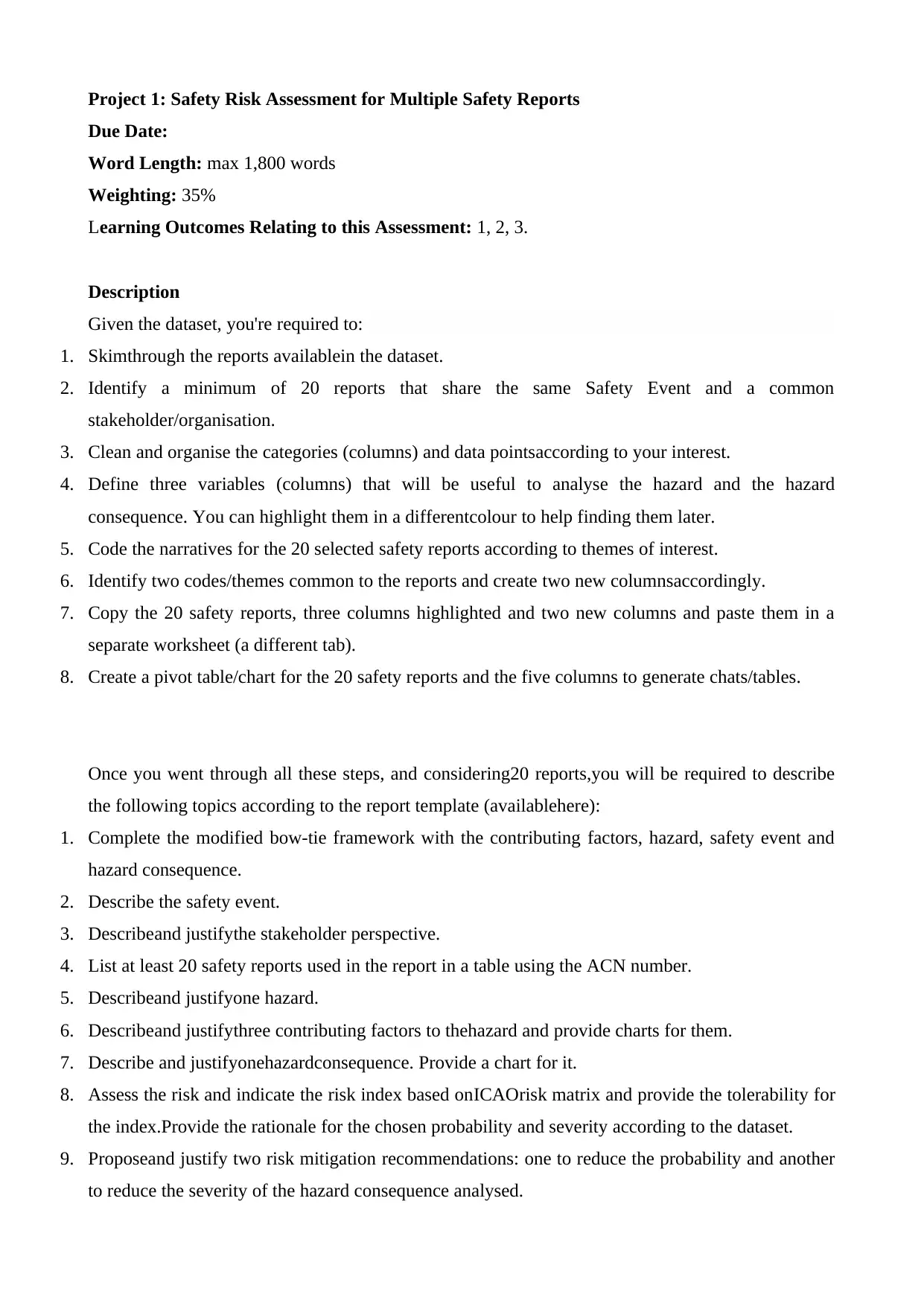
Project 1: Safety Risk Assessment for Multiple Safety Reports
Due Date:
Word Length: max 1,800 words
Weighting: 35%
Learning Outcomes Relating to this Assessment: 1, 2, 3.
Description
Given the dataset, you're required to:
1. Skimthrough the reports availablein the dataset.
2. Identify a minimum of 20 reports that share the same Safety Event and a common
stakeholder/organisation.
3. Clean and organise the categories (columns) and data pointsaccording to your interest.
4. Define three variables (columns) that will be useful to analyse the hazard and the hazard
consequence. You can highlight them in a differentcolour to help finding them later.
5. Code the narratives for the 20 selected safety reports according to themes of interest.
6. Identify two codes/themes common to the reports and create two new columnsaccordingly.
7. Copy the 20 safety reports, three columns highlighted and two new columns and paste them in a
separate worksheet (a different tab).
8. Create a pivot table/chart for the 20 safety reports and the five columns to generate chats/tables.
Once you went through all these steps, and considering20 reports,you will be required to describe
the following topics according to the report template (availablehere):
1. Complete the modified bow-tie framework with the contributing factors, hazard, safety event and
hazard consequence.
2. Describe the safety event.
3. Describeand justifythe stakeholder perspective.
4. List at least 20 safety reports used in the report in a table using the ACN number.
5. Describeand justifyone hazard.
6. Describeand justifythree contributing factors to thehazard and provide charts for them.
7. Describe and justifyonehazardconsequence. Provide a chart for it.
8. Assess the risk and indicate the risk index based onICAOrisk matrix and provide the tolerability for
the index.Provide the rationale for the chosen probability and severity according to the dataset.
9. Proposeand justify two risk mitigation recommendations: one to reduce the probability and another
to reduce the severity of the hazard consequence analysed.
Due Date:
Word Length: max 1,800 words
Weighting: 35%
Learning Outcomes Relating to this Assessment: 1, 2, 3.
Description
Given the dataset, you're required to:
1. Skimthrough the reports availablein the dataset.
2. Identify a minimum of 20 reports that share the same Safety Event and a common
stakeholder/organisation.
3. Clean and organise the categories (columns) and data pointsaccording to your interest.
4. Define three variables (columns) that will be useful to analyse the hazard and the hazard
consequence. You can highlight them in a differentcolour to help finding them later.
5. Code the narratives for the 20 selected safety reports according to themes of interest.
6. Identify two codes/themes common to the reports and create two new columnsaccordingly.
7. Copy the 20 safety reports, three columns highlighted and two new columns and paste them in a
separate worksheet (a different tab).
8. Create a pivot table/chart for the 20 safety reports and the five columns to generate chats/tables.
Once you went through all these steps, and considering20 reports,you will be required to describe
the following topics according to the report template (availablehere):
1. Complete the modified bow-tie framework with the contributing factors, hazard, safety event and
hazard consequence.
2. Describe the safety event.
3. Describeand justifythe stakeholder perspective.
4. List at least 20 safety reports used in the report in a table using the ACN number.
5. Describeand justifyone hazard.
6. Describeand justifythree contributing factors to thehazard and provide charts for them.
7. Describe and justifyonehazardconsequence. Provide a chart for it.
8. Assess the risk and indicate the risk index based onICAOrisk matrix and provide the tolerability for
the index.Provide the rationale for the chosen probability and severity according to the dataset.
9. Proposeand justify two risk mitigation recommendations: one to reduce the probability and another
to reduce the severity of the hazard consequence analysed.
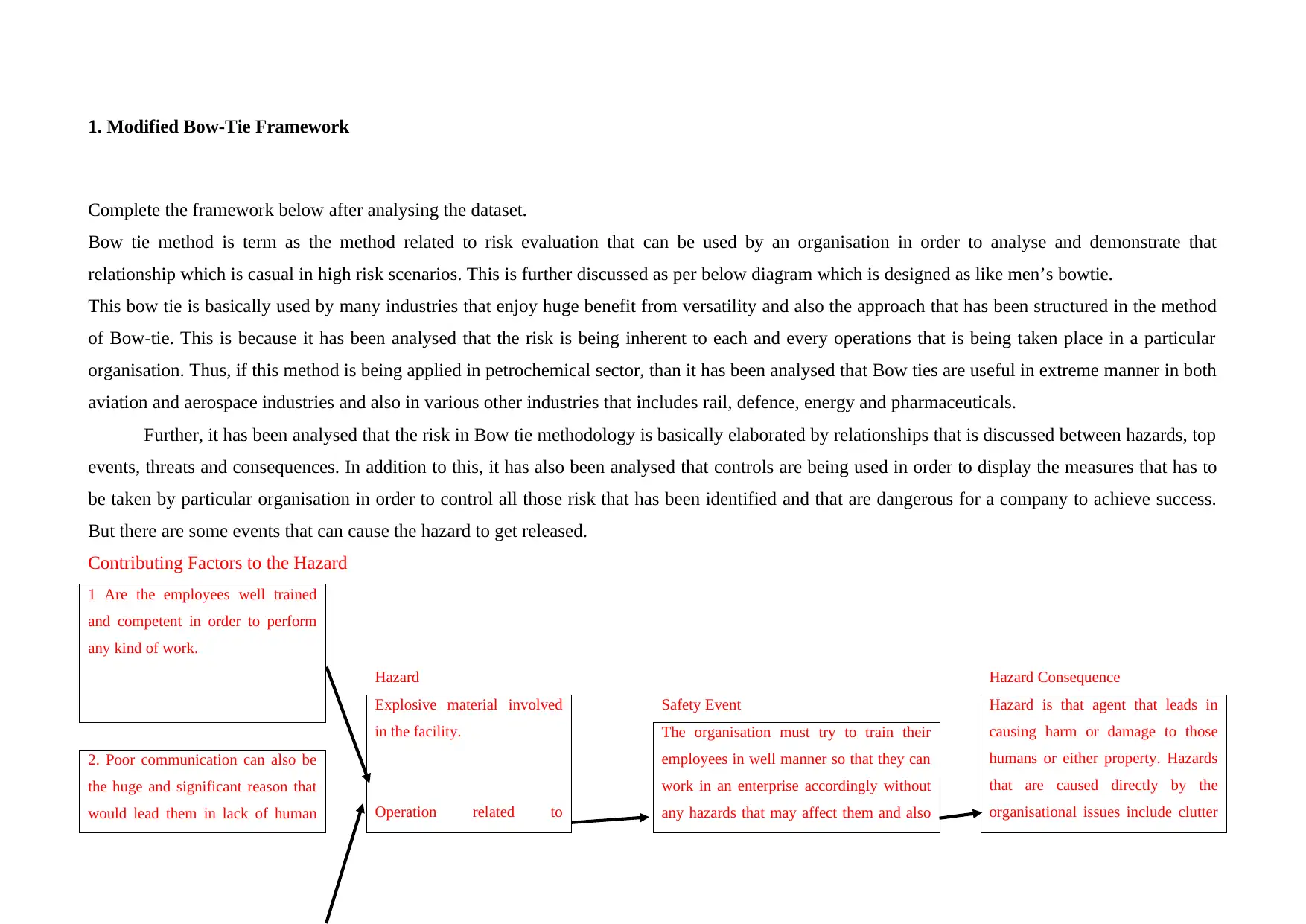
1. Modified Bow-Tie Framework
Complete the framework below after analysing the dataset.
Bow tie method is term as the method related to risk evaluation that can be used by an organisation in order to analyse and demonstrate that
relationship which is casual in high risk scenarios. This is further discussed as per below diagram which is designed as like men’s bowtie.
This bow tie is basically used by many industries that enjoy huge benefit from versatility and also the approach that has been structured in the method
of Bow-tie. This is because it has been analysed that the risk is being inherent to each and every operations that is being taken place in a particular
organisation. Thus, if this method is being applied in petrochemical sector, than it has been analysed that Bow ties are useful in extreme manner in both
aviation and aerospace industries and also in various other industries that includes rail, defence, energy and pharmaceuticals.
Further, it has been analysed that the risk in Bow tie methodology is basically elaborated by relationships that is discussed between hazards, top
events, threats and consequences. In addition to this, it has also been analysed that controls are being used in order to display the measures that has to
be taken by particular organisation in order to control all those risk that has been identified and that are dangerous for a company to achieve success.
But there are some events that can cause the hazard to get released.
Contributing Factors to the Hazard
1 Are the employees well trained
and competent in order to perform
any kind of work.
Hazard Hazard Consequence
Explosive material involved
in the facility.
Operation related to
Safety Event Hazard is that agent that leads in
causing harm or damage to those
humans or either property. Hazards
that are caused directly by the
organisational issues include clutter
The organisation must try to train their
employees in well manner so that they can
work in an enterprise accordingly without
any hazards that may affect them and also
2. Poor communication can also be
the huge and significant reason that
would lead them in lack of human
Complete the framework below after analysing the dataset.
Bow tie method is term as the method related to risk evaluation that can be used by an organisation in order to analyse and demonstrate that
relationship which is casual in high risk scenarios. This is further discussed as per below diagram which is designed as like men’s bowtie.
This bow tie is basically used by many industries that enjoy huge benefit from versatility and also the approach that has been structured in the method
of Bow-tie. This is because it has been analysed that the risk is being inherent to each and every operations that is being taken place in a particular
organisation. Thus, if this method is being applied in petrochemical sector, than it has been analysed that Bow ties are useful in extreme manner in both
aviation and aerospace industries and also in various other industries that includes rail, defence, energy and pharmaceuticals.
Further, it has been analysed that the risk in Bow tie methodology is basically elaborated by relationships that is discussed between hazards, top
events, threats and consequences. In addition to this, it has also been analysed that controls are being used in order to display the measures that has to
be taken by particular organisation in order to control all those risk that has been identified and that are dangerous for a company to achieve success.
But there are some events that can cause the hazard to get released.
Contributing Factors to the Hazard
1 Are the employees well trained
and competent in order to perform
any kind of work.
Hazard Hazard Consequence
Explosive material involved
in the facility.
Operation related to
Safety Event Hazard is that agent that leads in
causing harm or damage to those
humans or either property. Hazards
that are caused directly by the
organisational issues include clutter
The organisation must try to train their
employees in well manner so that they can
work in an enterprise accordingly without
any hazards that may affect them and also
2. Poor communication can also be
the huge and significant reason that
would lead them in lack of human
⊘ This is a preview!⊘
Do you want full access?
Subscribe today to unlock all pages.

Trusted by 1+ million students worldwide
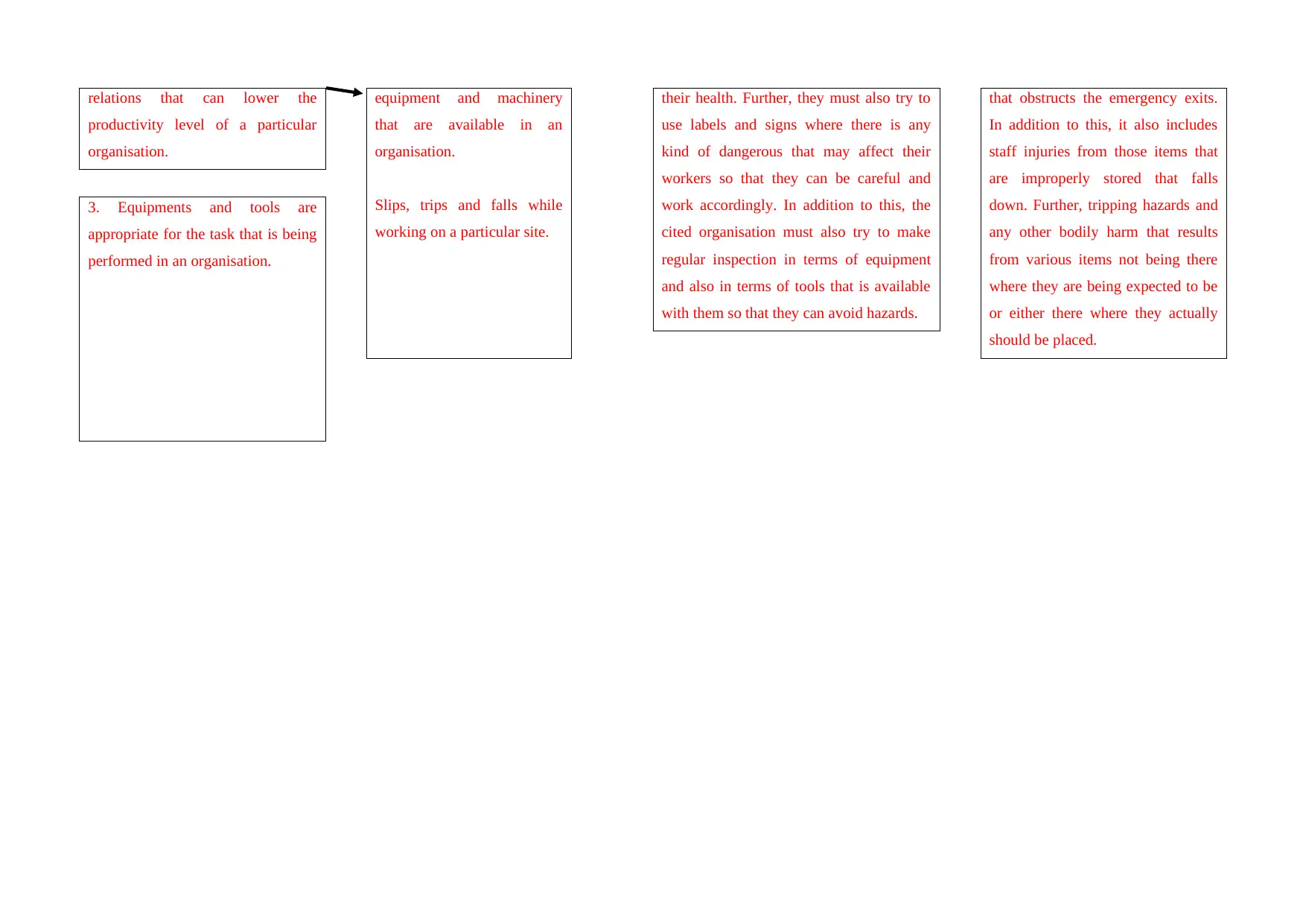
relations that can lower the
productivity level of a particular
organisation.
equipment and machinery
that are available in an
organisation.
Slips, trips and falls while
working on a particular site.
their health. Further, they must also try to
use labels and signs where there is any
kind of dangerous that may affect their
workers so that they can be careful and
work accordingly. In addition to this, the
cited organisation must also try to make
regular inspection in terms of equipment
and also in terms of tools that is available
with them so that they can avoid hazards.
that obstructs the emergency exits.
In addition to this, it also includes
staff injuries from those items that
are improperly stored that falls
down. Further, tripping hazards and
any other bodily harm that results
from various items not being there
where they are being expected to be
or either there where they actually
should be placed.
3. Equipments and tools are
appropriate for the task that is being
performed in an organisation.
productivity level of a particular
organisation.
equipment and machinery
that are available in an
organisation.
Slips, trips and falls while
working on a particular site.
their health. Further, they must also try to
use labels and signs where there is any
kind of dangerous that may affect their
workers so that they can be careful and
work accordingly. In addition to this, the
cited organisation must also try to make
regular inspection in terms of equipment
and also in terms of tools that is available
with them so that they can avoid hazards.
that obstructs the emergency exits.
In addition to this, it also includes
staff injuries from those items that
are improperly stored that falls
down. Further, tripping hazards and
any other bodily harm that results
from various items not being there
where they are being expected to be
or either there where they actually
should be placed.
3. Equipments and tools are
appropriate for the task that is being
performed in an organisation.
Paraphrase This Document
Need a fresh take? Get an instant paraphrase of this document with our AI Paraphraser
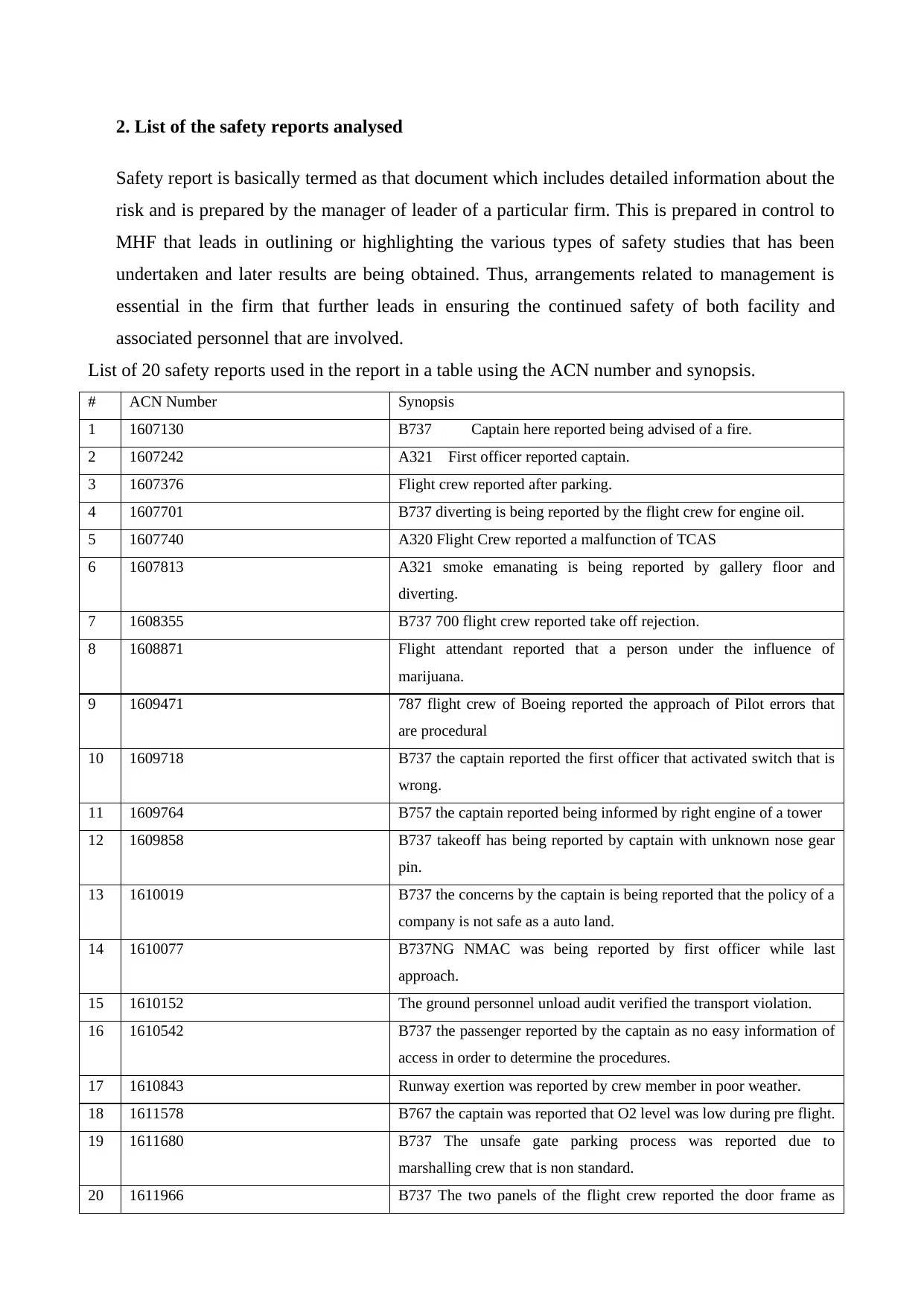
2. List of the safety reports analysed
Safety report is basically termed as that document which includes detailed information about the
risk and is prepared by the manager of leader of a particular firm. This is prepared in control to
MHF that leads in outlining or highlighting the various types of safety studies that has been
undertaken and later results are being obtained. Thus, arrangements related to management is
essential in the firm that further leads in ensuring the continued safety of both facility and
associated personnel that are involved.
List of 20 safety reports used in the report in a table using the ACN number and synopsis.
# ACN Number Synopsis
1 1607130 B737 Captain here reported being advised of a fire.
2 1607242 A321 First officer reported captain.
3 1607376 Flight crew reported after parking.
4 1607701 B737 diverting is being reported by the flight crew for engine oil.
5 1607740 A320 Flight Crew reported a malfunction of TCAS
6 1607813 A321 smoke emanating is being reported by gallery floor and
diverting.
7 1608355 B737 700 flight crew reported take off rejection.
8 1608871 Flight attendant reported that a person under the influence of
marijuana.
9 1609471 787 flight crew of Boeing reported the approach of Pilot errors that
are procedural
10 1609718 B737 the captain reported the first officer that activated switch that is
wrong.
11 1609764 B757 the captain reported being informed by right engine of a tower
12 1609858 B737 takeoff has being reported by captain with unknown nose gear
pin.
13 1610019 B737 the concerns by the captain is being reported that the policy of a
company is not safe as a auto land.
14 1610077 B737NG NMAC was being reported by first officer while last
approach.
15 1610152 The ground personnel unload audit verified the transport violation.
16 1610542 B737 the passenger reported by the captain as no easy information of
access in order to determine the procedures.
17 1610843 Runway exertion was reported by crew member in poor weather.
18 1611578 B767 the captain was reported that O2 level was low during pre flight.
19 1611680 B737 The unsafe gate parking process was reported due to
marshalling crew that is non standard.
20 1611966 B737 The two panels of the flight crew reported the door frame as
Safety report is basically termed as that document which includes detailed information about the
risk and is prepared by the manager of leader of a particular firm. This is prepared in control to
MHF that leads in outlining or highlighting the various types of safety studies that has been
undertaken and later results are being obtained. Thus, arrangements related to management is
essential in the firm that further leads in ensuring the continued safety of both facility and
associated personnel that are involved.
List of 20 safety reports used in the report in a table using the ACN number and synopsis.
# ACN Number Synopsis
1 1607130 B737 Captain here reported being advised of a fire.
2 1607242 A321 First officer reported captain.
3 1607376 Flight crew reported after parking.
4 1607701 B737 diverting is being reported by the flight crew for engine oil.
5 1607740 A320 Flight Crew reported a malfunction of TCAS
6 1607813 A321 smoke emanating is being reported by gallery floor and
diverting.
7 1608355 B737 700 flight crew reported take off rejection.
8 1608871 Flight attendant reported that a person under the influence of
marijuana.
9 1609471 787 flight crew of Boeing reported the approach of Pilot errors that
are procedural
10 1609718 B737 the captain reported the first officer that activated switch that is
wrong.
11 1609764 B757 the captain reported being informed by right engine of a tower
12 1609858 B737 takeoff has being reported by captain with unknown nose gear
pin.
13 1610019 B737 the concerns by the captain is being reported that the policy of a
company is not safe as a auto land.
14 1610077 B737NG NMAC was being reported by first officer while last
approach.
15 1610152 The ground personnel unload audit verified the transport violation.
16 1610542 B737 the passenger reported by the captain as no easy information of
access in order to determine the procedures.
17 1610843 Runway exertion was reported by crew member in poor weather.
18 1611578 B767 the captain was reported that O2 level was low during pre flight.
19 1611680 B737 The unsafe gate parking process was reported due to
marshalling crew that is non standard.
20 1611966 B737 The two panels of the flight crew reported the door frame as
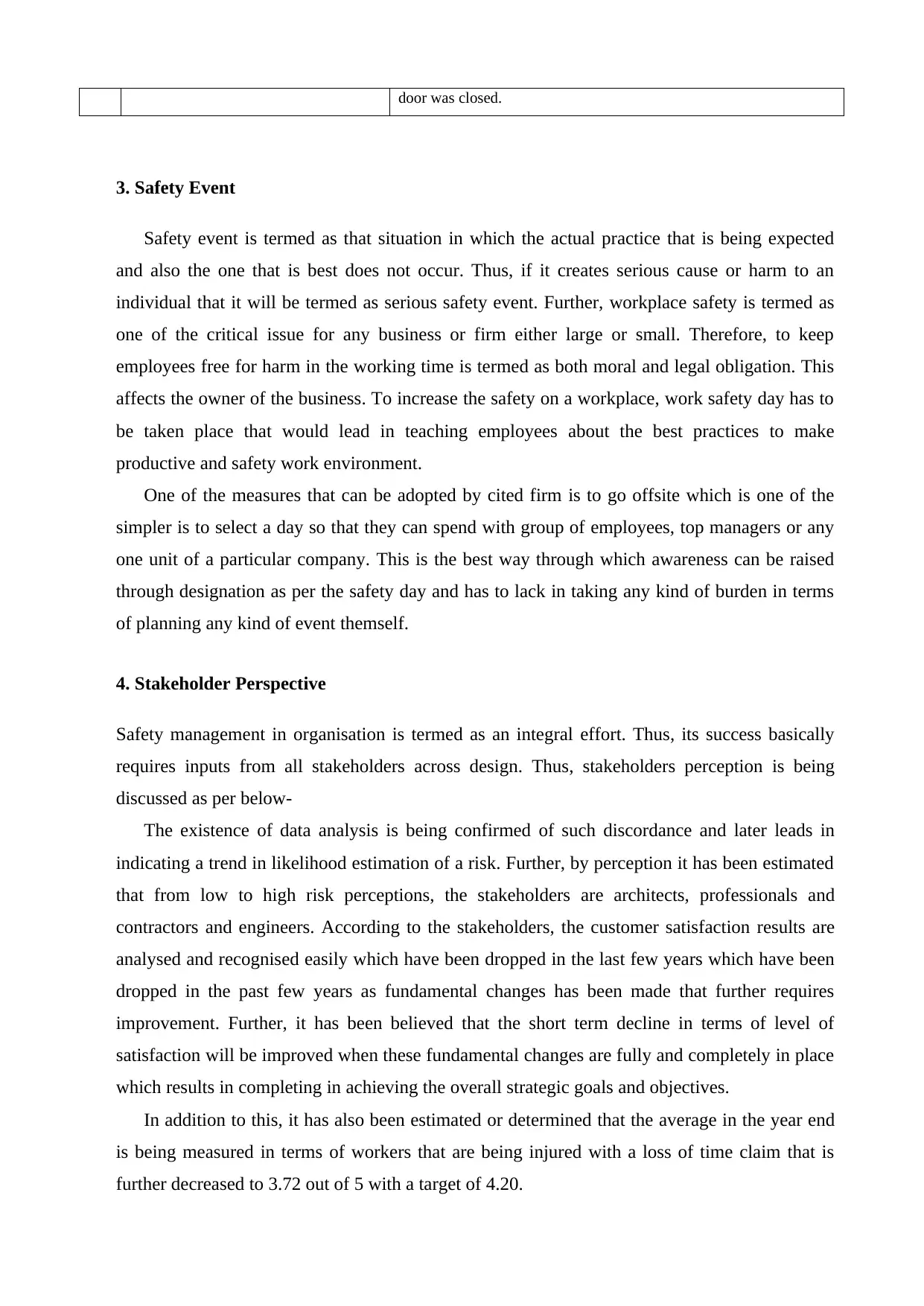
door was closed.
3. Safety Event
Safety event is termed as that situation in which the actual practice that is being expected
and also the one that is best does not occur. Thus, if it creates serious cause or harm to an
individual that it will be termed as serious safety event. Further, workplace safety is termed as
one of the critical issue for any business or firm either large or small. Therefore, to keep
employees free for harm in the working time is termed as both moral and legal obligation. This
affects the owner of the business. To increase the safety on a workplace, work safety day has to
be taken place that would lead in teaching employees about the best practices to make
productive and safety work environment.
One of the measures that can be adopted by cited firm is to go offsite which is one of the
simpler is to select a day so that they can spend with group of employees, top managers or any
one unit of a particular company. This is the best way through which awareness can be raised
through designation as per the safety day and has to lack in taking any kind of burden in terms
of planning any kind of event themself.
4. Stakeholder Perspective
Safety management in organisation is termed as an integral effort. Thus, its success basically
requires inputs from all stakeholders across design. Thus, stakeholders perception is being
discussed as per below-
The existence of data analysis is being confirmed of such discordance and later leads in
indicating a trend in likelihood estimation of a risk. Further, by perception it has been estimated
that from low to high risk perceptions, the stakeholders are architects, professionals and
contractors and engineers. According to the stakeholders, the customer satisfaction results are
analysed and recognised easily which have been dropped in the last few years which have been
dropped in the past few years as fundamental changes has been made that further requires
improvement. Further, it has been believed that the short term decline in terms of level of
satisfaction will be improved when these fundamental changes are fully and completely in place
which results in completing in achieving the overall strategic goals and objectives.
In addition to this, it has also been estimated or determined that the average in the year end
is being measured in terms of workers that are being injured with a loss of time claim that is
further decreased to 3.72 out of 5 with a target of 4.20.
3. Safety Event
Safety event is termed as that situation in which the actual practice that is being expected
and also the one that is best does not occur. Thus, if it creates serious cause or harm to an
individual that it will be termed as serious safety event. Further, workplace safety is termed as
one of the critical issue for any business or firm either large or small. Therefore, to keep
employees free for harm in the working time is termed as both moral and legal obligation. This
affects the owner of the business. To increase the safety on a workplace, work safety day has to
be taken place that would lead in teaching employees about the best practices to make
productive and safety work environment.
One of the measures that can be adopted by cited firm is to go offsite which is one of the
simpler is to select a day so that they can spend with group of employees, top managers or any
one unit of a particular company. This is the best way through which awareness can be raised
through designation as per the safety day and has to lack in taking any kind of burden in terms
of planning any kind of event themself.
4. Stakeholder Perspective
Safety management in organisation is termed as an integral effort. Thus, its success basically
requires inputs from all stakeholders across design. Thus, stakeholders perception is being
discussed as per below-
The existence of data analysis is being confirmed of such discordance and later leads in
indicating a trend in likelihood estimation of a risk. Further, by perception it has been estimated
that from low to high risk perceptions, the stakeholders are architects, professionals and
contractors and engineers. According to the stakeholders, the customer satisfaction results are
analysed and recognised easily which have been dropped in the last few years which have been
dropped in the past few years as fundamental changes has been made that further requires
improvement. Further, it has been believed that the short term decline in terms of level of
satisfaction will be improved when these fundamental changes are fully and completely in place
which results in completing in achieving the overall strategic goals and objectives.
In addition to this, it has also been estimated or determined that the average in the year end
is being measured in terms of workers that are being injured with a loss of time claim that is
further decreased to 3.72 out of 5 with a target of 4.20.
⊘ This is a preview!⊘
Do you want full access?
Subscribe today to unlock all pages.

Trusted by 1+ million students worldwide
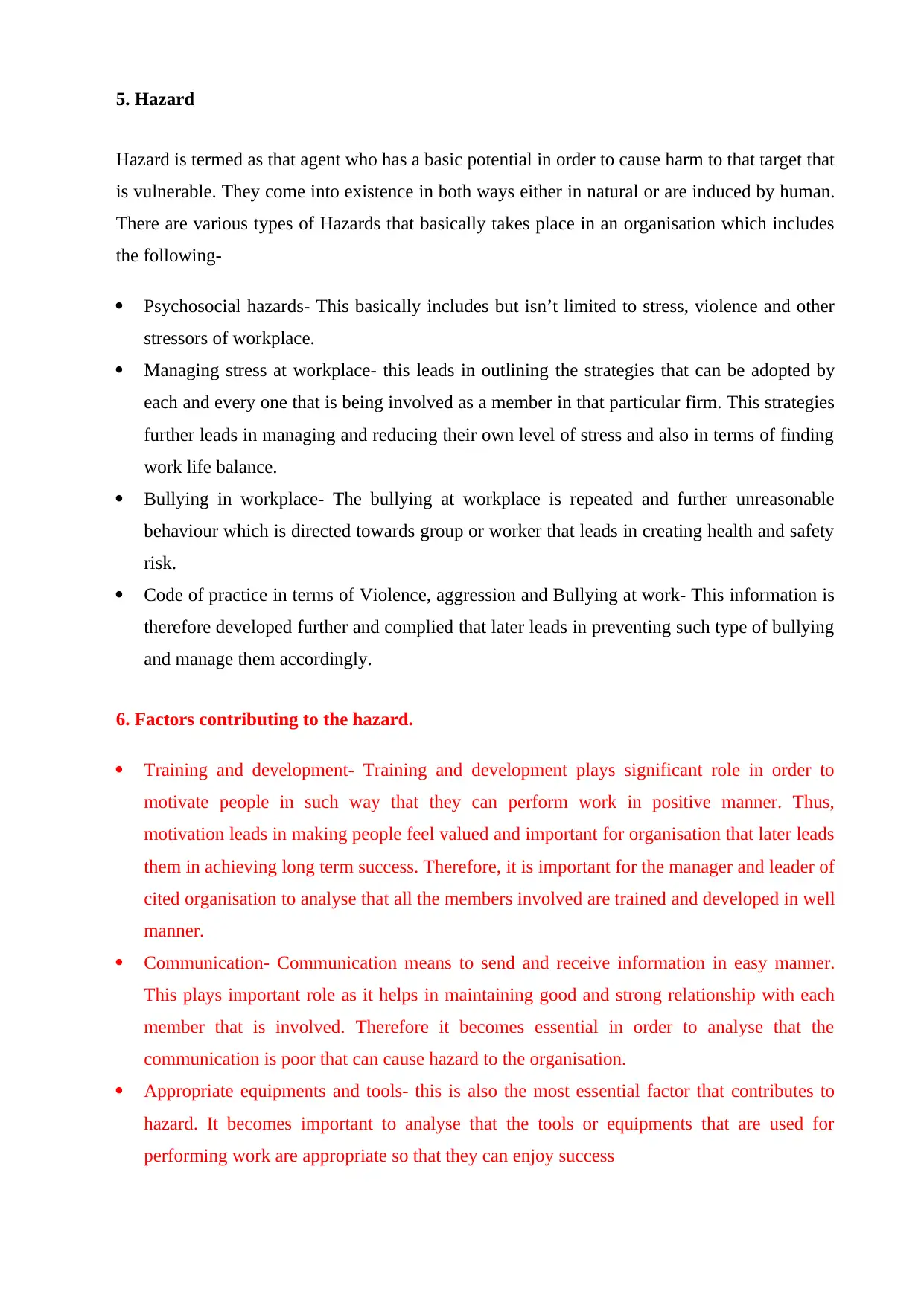
5. Hazard
Hazard is termed as that agent who has a basic potential in order to cause harm to that target that
is vulnerable. They come into existence in both ways either in natural or are induced by human.
There are various types of Hazards that basically takes place in an organisation which includes
the following-
Psychosocial hazards- This basically includes but isn’t limited to stress, violence and other
stressors of workplace.
Managing stress at workplace- this leads in outlining the strategies that can be adopted by
each and every one that is being involved as a member in that particular firm. This strategies
further leads in managing and reducing their own level of stress and also in terms of finding
work life balance.
Bullying in workplace- The bullying at workplace is repeated and further unreasonable
behaviour which is directed towards group or worker that leads in creating health and safety
risk.
Code of practice in terms of Violence, aggression and Bullying at work- This information is
therefore developed further and complied that later leads in preventing such type of bullying
and manage them accordingly.
6. Factors contributing to the hazard.
Training and development- Training and development plays significant role in order to
motivate people in such way that they can perform work in positive manner. Thus,
motivation leads in making people feel valued and important for organisation that later leads
them in achieving long term success. Therefore, it is important for the manager and leader of
cited organisation to analyse that all the members involved are trained and developed in well
manner.
Communication- Communication means to send and receive information in easy manner.
This plays important role as it helps in maintaining good and strong relationship with each
member that is involved. Therefore it becomes essential in order to analyse that the
communication is poor that can cause hazard to the organisation.
Appropriate equipments and tools- this is also the most essential factor that contributes to
hazard. It becomes important to analyse that the tools or equipments that are used for
performing work are appropriate so that they can enjoy success
Hazard is termed as that agent who has a basic potential in order to cause harm to that target that
is vulnerable. They come into existence in both ways either in natural or are induced by human.
There are various types of Hazards that basically takes place in an organisation which includes
the following-
Psychosocial hazards- This basically includes but isn’t limited to stress, violence and other
stressors of workplace.
Managing stress at workplace- this leads in outlining the strategies that can be adopted by
each and every one that is being involved as a member in that particular firm. This strategies
further leads in managing and reducing their own level of stress and also in terms of finding
work life balance.
Bullying in workplace- The bullying at workplace is repeated and further unreasonable
behaviour which is directed towards group or worker that leads in creating health and safety
risk.
Code of practice in terms of Violence, aggression and Bullying at work- This information is
therefore developed further and complied that later leads in preventing such type of bullying
and manage them accordingly.
6. Factors contributing to the hazard.
Training and development- Training and development plays significant role in order to
motivate people in such way that they can perform work in positive manner. Thus,
motivation leads in making people feel valued and important for organisation that later leads
them in achieving long term success. Therefore, it is important for the manager and leader of
cited organisation to analyse that all the members involved are trained and developed in well
manner.
Communication- Communication means to send and receive information in easy manner.
This plays important role as it helps in maintaining good and strong relationship with each
member that is involved. Therefore it becomes essential in order to analyse that the
communication is poor that can cause hazard to the organisation.
Appropriate equipments and tools- this is also the most essential factor that contributes to
hazard. It becomes important to analyse that the tools or equipments that are used for
performing work are appropriate so that they can enjoy success
Paraphrase This Document
Need a fresh take? Get an instant paraphrase of this document with our AI Paraphraser
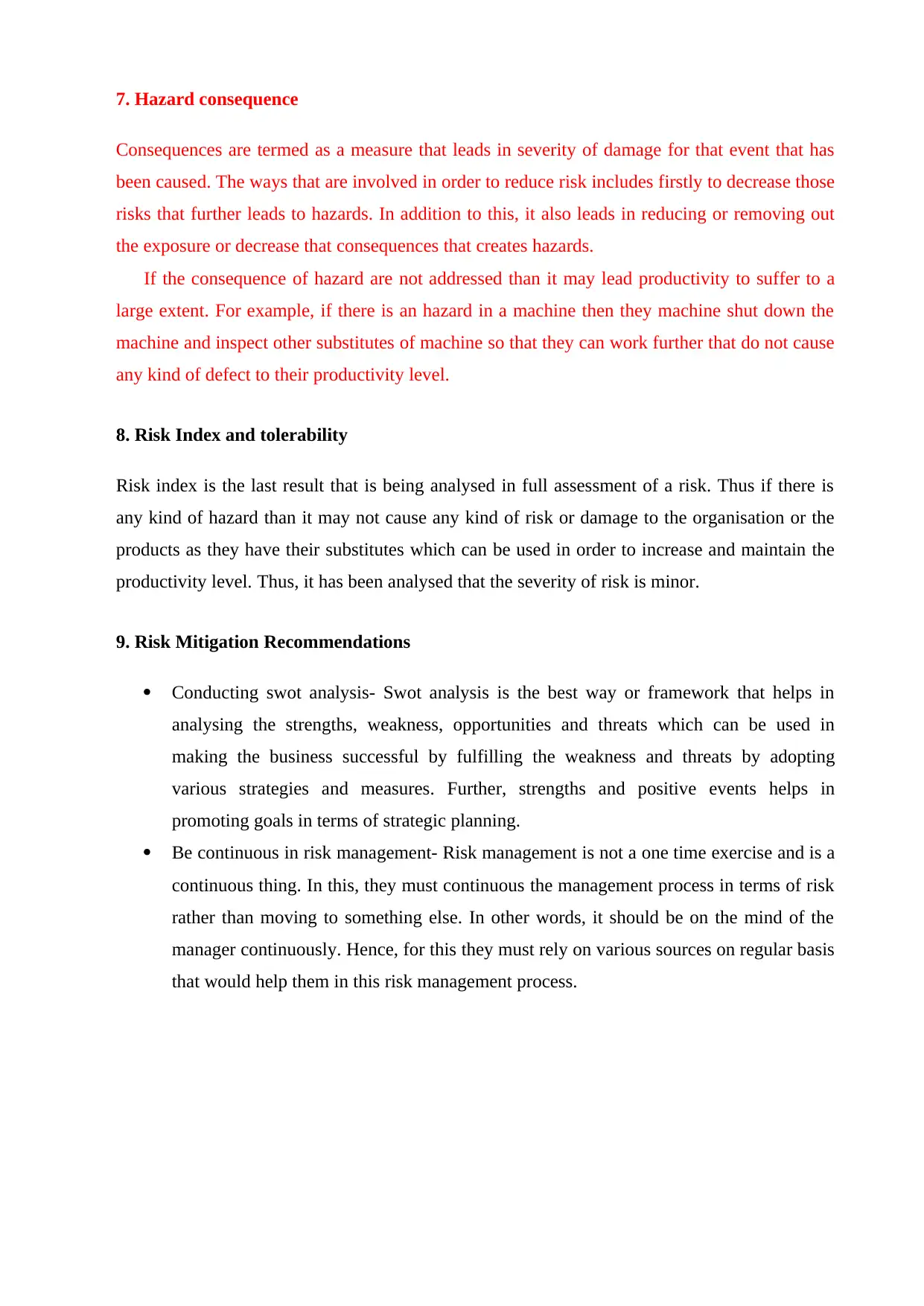
7. Hazard consequence
Consequences are termed as a measure that leads in severity of damage for that event that has
been caused. The ways that are involved in order to reduce risk includes firstly to decrease those
risks that further leads to hazards. In addition to this, it also leads in reducing or removing out
the exposure or decrease that consequences that creates hazards.
If the consequence of hazard are not addressed than it may lead productivity to suffer to a
large extent. For example, if there is an hazard in a machine then they machine shut down the
machine and inspect other substitutes of machine so that they can work further that do not cause
any kind of defect to their productivity level.
8. Risk Index and tolerability
Risk index is the last result that is being analysed in full assessment of a risk. Thus if there is
any kind of hazard than it may not cause any kind of risk or damage to the organisation or the
products as they have their substitutes which can be used in order to increase and maintain the
productivity level. Thus, it has been analysed that the severity of risk is minor.
9. Risk Mitigation Recommendations
Conducting swot analysis- Swot analysis is the best way or framework that helps in
analysing the strengths, weakness, opportunities and threats which can be used in
making the business successful by fulfilling the weakness and threats by adopting
various strategies and measures. Further, strengths and positive events helps in
promoting goals in terms of strategic planning.
Be continuous in risk management- Risk management is not a one time exercise and is a
continuous thing. In this, they must continuous the management process in terms of risk
rather than moving to something else. In other words, it should be on the mind of the
manager continuously. Hence, for this they must rely on various sources on regular basis
that would help them in this risk management process.
Consequences are termed as a measure that leads in severity of damage for that event that has
been caused. The ways that are involved in order to reduce risk includes firstly to decrease those
risks that further leads to hazards. In addition to this, it also leads in reducing or removing out
the exposure or decrease that consequences that creates hazards.
If the consequence of hazard are not addressed than it may lead productivity to suffer to a
large extent. For example, if there is an hazard in a machine then they machine shut down the
machine and inspect other substitutes of machine so that they can work further that do not cause
any kind of defect to their productivity level.
8. Risk Index and tolerability
Risk index is the last result that is being analysed in full assessment of a risk. Thus if there is
any kind of hazard than it may not cause any kind of risk or damage to the organisation or the
products as they have their substitutes which can be used in order to increase and maintain the
productivity level. Thus, it has been analysed that the severity of risk is minor.
9. Risk Mitigation Recommendations
Conducting swot analysis- Swot analysis is the best way or framework that helps in
analysing the strengths, weakness, opportunities and threats which can be used in
making the business successful by fulfilling the weakness and threats by adopting
various strategies and measures. Further, strengths and positive events helps in
promoting goals in terms of strategic planning.
Be continuous in risk management- Risk management is not a one time exercise and is a
continuous thing. In this, they must continuous the management process in terms of risk
rather than moving to something else. In other words, it should be on the mind of the
manager continuously. Hence, for this they must rely on various sources on regular basis
that would help them in this risk management process.
1 out of 11
Related Documents
Your All-in-One AI-Powered Toolkit for Academic Success.
+13062052269
info@desklib.com
Available 24*7 on WhatsApp / Email
![[object Object]](/_next/static/media/star-bottom.7253800d.svg)
Unlock your academic potential
Copyright © 2020–2025 A2Z Services. All Rights Reserved. Developed and managed by ZUCOL.




